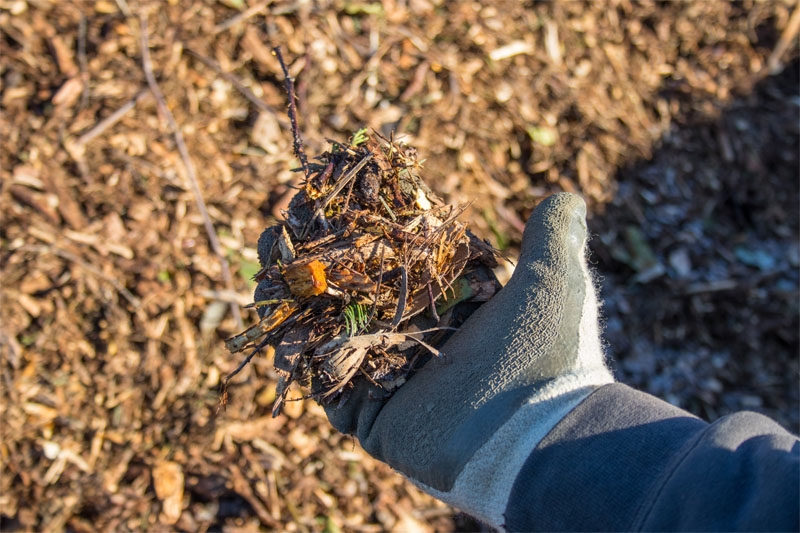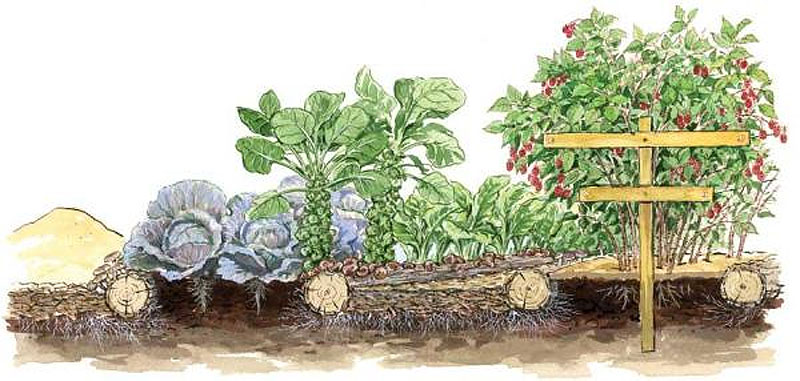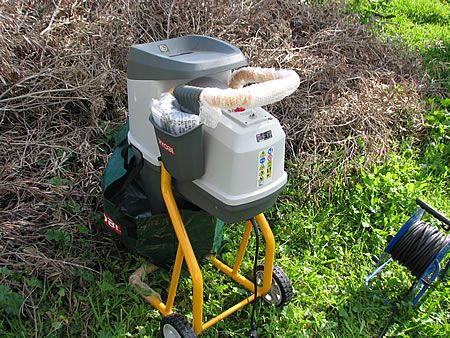The use of wood chips (shredded wood) in the garden is an old organic technique for enriching the soil with nutrients.
Wood chips are the product of the shredding of pruned tree branches using a compost shredder. Wood chips are small pieces of wood.
In this article I’ll discuss the use of wood chips in the garden and how they can dramatically improve the quality of soil (even nearly barren soil), control weed growth, reduce watering needs and finally help us have larger and more efficient vegetable crops in our garden.
It is based on the excellent work of Dr. Linda Chalker-Scott.
By spreading the wood chips made from the pruning of olive trees in various places in the garden, I noticed that in those places no weeds were growing, the soil underneath became soft and full of life. The same happened when I spread the wood chips around the trees. I wanted to look into it more. Find more about this.
How to make wood chips
Every year we all prune our trees. From olive trees to fruit trees to ornamental trees. But what do we do with the branches? Do we just throw them in the trash? Do we pile them up in a corner of the cottage? Do we burn them?
Until I got a compost shredder, managing branches was a problem. It was a hard to manage waste. After buying and using the compost shredder, it was a blessing.
The compost shredder is a machine that you put the pruned branches in the inlet and at the outlet you get the branches cut into small pieces. You get wood chips!
Compost shredders come in different sizes. From residential electric to large commercial gas-powered.
In the market you will find various sizes. Electric or gas powered. The larger the machine the more expensive it is, as it is able to shred branches of larger diameter.
For home use, expect the cost for a compost shredder to be in the range of 200 to 400 Euros.
Prices for large commercial compost shredders can go up to a few thousand Euros.
How do we make use of wood chips in the garden?
We spread the wood chips on the part of the garden where we want to improve the soil.
The ideal thickness that the layer of wood chips should be, is more than 10 cm thick. Research has shown that when the thickness of the layer exceeds 50 cm (yes you read that right), then problems start to occur due to poor soil aeration.
We don’t “disturb” the area for a few months. We don’t dig, don’t mix, don’t plant in that area for a few months. We let the layer of wood chips take effect. If it doesn’t rain for over a month, we can water the place.
The exception is when we lay the wood chips around the trees. There we have to water regularly and sometimes we have to dig.
Wood chips in relation to other forms of soil improvement
In 1990 a study was carried out to evaluate the effectiveness of different types of organic material as a soil cover and a means of improving soil quality. Especially in soils that are almost barren.
15 organic cover materials were evaluated. Among the organic soil amendment materials evaluated were: grass clippings, leaves, tree bark, and wood chips.
Wood chips was one of the organic materials with the best performance in terms of moisture retention, soil temperature stabilization, control on weed growth, longevity of results, and soil improvement.
Do not confuse wood chips with tree bark and sawdust
Do not confuse wood chips with tree bark chips and sawdust.
They are completely different materials.
Tree bark chips and sawdust are mainly composed of uniform materials. In contrast, wood chips are composed of unevenly sized pieces of wood, pieces of bark and in many cases leaves (as in olive trees).
Due to the variety of materials contained in wood chips, there is a range of values in their chemical and physiological composition. The same applies to the rate of degradation (decomposition).
The wood chips degrade (decompose) at a slow rate. Their tissues are rich in lignin, tannins and other decay-resistant chemical compounds.
Thus, the wood chips slowly provides its nutrients to the soil.
At the same time they absorb significant amounts of water which they slowly release into the soil.
For these reasons, wood chips are considered to be a leading organic material for soil improvement.
In fact, Dr. Linda Chalker-Scott, reports an experiment where a layer of wood chips was placed on a completely barren hard soil that had been uncultivated for decades (what we call dead soil) next to a bus stop. Without any other intervention, within a year the soil had changed and become nutrient-rich and suitable for cultivation.
This example made a great impression on me.
Immediate benefits of using wood chips as a soil conditioner to get fertile soil
Benefits to the soil
- Improvement of soil structure
- Improves air circulation
- Increases water retention and helps with filtration
- Prevents soil erosion and compaction
- Maintains a constant temperature in the soil
Benefits for plants
- Provides nutrients to plants
Benefits to the environment
- Controls the growth of pathogens and harmful insects
- Encourages the growth of beneficial organisms
- Encourages biodiversity
- Neutralizes pollutants
Benefits for the gardener
- Economical way to improve the soil
- Aesthetically beautiful
- Easy to apply
- No need for monitoring after application
Frequently asked questions and answers on the use of wood chips
Wood chips improve soil quality and increase yields
Will wood chips make the soil acidic?
No. Wood chips will not make the soil acidic by lowering the pH.
Can I use wood chips from conifers?
Do not mix conifer prunings with branches from other trees.
If you have prunings from conifers, spread them separately in another area.
If the tree is diseased, can I use the prunings to make wood chips?
Most studies show that chips from diseased trees cannot spread disease to the roots of healthy trees.
Are wood chips flammable?
When wood chips are spread in the garden, they are the least flammable of the organic materials used to improve the soil. Sawdust and tree trunks are more flammable.
Do wood chips fix nitrogen and create nitrogen deficiency in plants?
Actually, many studies have shown that wood chips increase nitrogen yield in plants.
Will wood chips attract insects and ants?
Wood chips attract mainly beneficial insects.
Can I use the wood chips immediately or do I have to let them mature first?
You can use the wood chips immediately (while they are still wet).
Before I put wood chips on top of the soil I want to improve, do I have to apply compost first?
It is not necessary.
But if you pour a layer of compost first then you are creating a sandwich and mimicking what happens in the natural ecosystem of a forest. But it is not necessary.
Do wood chips prevent the growth of weeds?
In the area where you spread the wood chips, no weeds will grow.
The greater the thickness (over 10 cm but less than 50 cm) the more effective weed control you will have.
How thick does the woodchip layer need to be?
The thickness of the wood chips layer should be such that it will prevent weed growth and help create a healthy soil.
In ornamental gardens, the thickness of the wood chip layer should be 10 cm to 15 cm.
In places where we want to improve the quality of the soil, the thickness of the layer of wood chips should be 20 to 30 cm.
Research has shown that when the thickness of the wood chips layer exceeds 50 cm, then problems start to occur due to poor soil aeration.
Epilogue
You can use the prunings from the trees to make wood chips with a compost shredder.
Wood chips are used to dramatically improve the quality of even barren (dead) soil.
Tags: COMPOST SHREDDER • COMPOST SHREDDERS • MANURE • SOIL • SOIL AMENDMENTS • WOOD CHIPS






